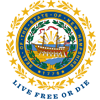Press Release
Contact
DHHS Identifies Francestown Horse With Eastern Equine Encephalitis
Concord, NH – The New Hampshire Department of Health and Human Services (DHHS) announced that a horse from Francestown has tested positive for Eastern Equine Encephalitis (EEE) virus infection. This is the second finding of EEE in a horse this year; the first was identified on August 28th in Northwood. The same mosquitoes that can cause disease in horses are also capable of causing disease in humans.
The arboviral risk level for Francestown will be increased to high. The arboviral risk level indicates the risk of transmission of these infections to people from mosquitoes. The surrounding towns of Bennington, Deering, Francestown, Greenfield, Lyndeborough, New Boston and Weare will increase to moderate.
“It is critical to keep using personal protective measures like insect repellent this time of year until we have a hard frost statewide,” said Lisa Morris, Director, Division of Public Health Services. “We want everyone to enjoy outdoor activities while taking the appropriate steps to prevent mosquito bites that may cause serious and potentially fatal illnesses.”
EEE is one of three mosquito-transmitted diseases present in New Hampshire, including West Nile Virus (WNV) and Jamestown Canyon virus (JCV), and was first identified in the State in August of 2004. Since 2004, there have been 15 human infections with EEE identified in NH; the last human case of EEE in NH was in 2014, when there were three cases. There have been no EEE infections identified yet this season in humans.
Any horse that resides in or travels to New Hampshire during mosquito season is at risk of becoming infected with EEE, WNV or JCV. Because of this risk, it is recommended that horse owners consult with their veterinarians to discuss appropriate vaccination schedules based on their risk factors.
Symptoms of EEE virus usually appear 4 to 10 days after being bitten by a mosquito carrying the EEE virus. People who get sick from EEE can develop a flu-like illness, including fever, headache, weakness, and muscle and joint pains. A more serious central nervous system infection can develop such as meningitis and encephalitis (inflammation of the brain). EEE typically causes a more serious disease than WNV and carries a high mortality rate for those who contract the serious encephalitic form of the illness. There is no specific treatment for the disease.
Prevention guidelines for EEE and other arboviruses can be found below. Anyone with questions about arboviruses, including EEE, can call the New Hampshire Bureau of Infectious Disease Control at 603-271-4496. Fact Sheets on Easter Equine Encephalitis and other arboviruses are available on the DHHS website. For more information, please visit the Centers for Disease Control and Prevention website at www.cdc.gov.
Prevention Guidelines for Mosquito and Tick Diseases
- Eliminate habitat and breeding locations.
- Mosquitoes
- Mosquitoes lay their eggs in standing water. Remove outdoor items that hold water (old tires, cans, plastic containers, ceramic pots).
- Drill holes in the bottom of outdoor recycling containers, clean roof gutters and ensure proper drainage.
- If not in use, empty and/or cover swimming pools, wading pools and hot tubs.
- Turn over wheelbarrows and change water in birdbaths at least twice weekly.
- Ticks
- Minimizing areas where hosts for the ticks, such as rodents and deer, can congregate to eat, sleep or feed.
- Mosquitoes
- Be aware of where mosquitoes and ticks live.
- Weeds, tall grass, and bushes provide an outdoor home for mosquitoes and ticks, alike.
- Make sure that doors and windows have tight-fitting screens. Repair or replace all screens in your home that have tears or holes.
- Resting mosquitoes can often be flushed from indoor resting sites by using sweeping motions under beds, behind bedside tables etc. and once in flight, exterminated prior to sleeping at night.
- Avoid tick-infested areas. If in tick-infested areas, walk in the center of trails to avoid contact with overgrown grass, brush, and leaf litter at trail edges.
- Protect yourself from bites.
- When outside, wear protective clothing such as socks, long-sleeved shirts, and long pants (preferably tucked in socks). Light-colored clothing helps you spot ticks.
- Wear insect repellents, such as one containing 30% or less DEET (N,N-diethyl-methyl-meta-toluamide), Picaridin, para-menthane-diol, IR3535, or 2-undecanone or oil of lemon eucalyptus.
- Treat clothing with permethrin, ideal for hunters as it is odorless when dry.
- Vitamin B, ultrasonic devices, incense, and bug zappers have not been shown to be effective in preventing mosquito bites.
- Shower as soon as possible after spending time outdoors.
- Check for ticks daily, on you and your pets. Ticks can hide under the armpits, behind the knees, in the hair, and in the groin.
- Wash and dry clothing after being outdoors. Tumble clothes in a dryer on high heat for 10 minutes to kill ticks on dry clothing. If the clothes are damp, additional time may be needed.
- Early removal of ticks can reduce the risk of infection. Inspect all body surfaces carefully, and remove attached ticks with tweezers. Monitor your health closely after a tick bite and be alert for symptoms of illness. Contact your physician to discuss testing and treatment.



